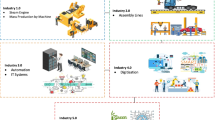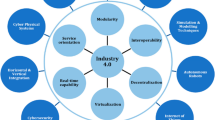Abstract
In many industries the focus in CAx based manufacturing has changed from fixed process chains to ones which can adapt to dynamic inputs. This way process chains can take measurement data into account to produce optimal results. Unfortunately, existing approaches do not integrate well with the existing CAx systems since they do not ensure that existing processes will be kept unchanged. This restriction leads to a low adaption rate in some industries. Especially in the aerospace industry every change in the manufacturing processes will result in high costs. In this paper it is shown that an extended function block approach can be integrated with existing CAx systems while allowing the modeling and controlling of adaptive process chains with reduced data loss at the same time. In order to achieve this goal, data port manifests are introduced which announce supported data formats and features of the corresponding function block. This extension reduces information loss at system interfaces and helps to ensure that required data will be transferred between function blocks. A case study will show how this extension can be used in a common CAx system.













Similar content being viewed by others
References
3D Systems Inc. (1989) Stereolithography interface specification, Valencia, CA
AdaM: Innovation Cluster AdaM. http://www.innovationscluster-adam.de/en.html (Cited 03 December 2014)
Altmüller S, Bergs T, Börsch W, Jelich C, Klocke F, Kriegl B, Murtezaoglu Y, Siebenwurst C, Witty M (2011) Beherrschung adaptiver Prozessketten. Wettbewerbsfaktor Produktionstechnik, Aachener Perspektiven, Aachener Werkzeugmaschinen-Kolloquium, Shaker, Aachen, p 405–422
Auerbach T, Bauhoff F, Beckers M, Behnen D, Brecher C, Brosze T, Buchholz G, Büscher C, Corves B, Eppelt U et al (2011) Selbstoptimierende Produktionssysteme. In: Brecher C (ed) Integrative Produktionstechnik für Hochlohnländer. VDI-Buch. Springer, Heidelberg, pp 747–1057
Biermann D, Gausemeier J, Hess S, Petersen M, Wagner T (2013) Planning and optimisation of manufacturing process chains for functionally graded components–part 1: methodological foundations. Prod Eng 7(6):657–664
Brecher C, Vitr M, Wolf J (2006) Closed-loop CAPP/CAM/CNC process chain based on STEP and STEP-NC inspection tasks. Int J Comput Integr Manuf 19(6):570–580
Brecher C, Lohse W, Vitr M (2009) Module-based Platform for Seamless Interoperable CAD-CAM-CNC Planning. In: Advanced design and manufacturing based on STEP, Springer, p 439–462
Denkena B, Behrens BA, Charlin F, Dannenberg M (2012) Integrative process chain optimization using a Genetic Algorithm. Prod Eng 6(1):29–37
Denkena B, Lorenzen LE, Schmidt J (2012) Adaptive process planning. Prod Eng 6(1):55–67
Haasis S (1995) Integrierte CAD-Anwendungen, Rationalisierungspotentiale und zukünftige Einsatzgebiete. Springer, Berlin
Hehenberger P (2011) Computerunterstützte Fertigung, Eine kompakte Einführung. Springer, Berlin
International Electrotechnical Commission (2005) IEC 61499–1: function blocks–part 1 architecture
ISO 10303-21, industrial automation systems and integration—product data representation and exchange–Part 21: implementation methods: clear text encoding of the exchange structure. International Organization for Standardization (2002)
ISO 14649-1, industrial automation systems and integration—physical device control—data model for computerized numerical controllers–part 1: overview and fundamental principles. International Organization for Standardization (2003)
Klocke F, Bobek T, Holstein M, Kappmeyer G, Rossgoderer U, Schug P, Stautner M (2014) Durchgängigkeit von Datenflüssen und virtuelle Programmoptimierung. In: Integrative Produktion–Industrie 4.0, Aachener Perspektiven. Aachener Werkzeugmaschinen-Kolloquium, Shaker, Aachen, p 101–119
Klocke F, Kuchle A (2011) Manufacturing processes 1: cutting. Springer, Berlin
Laguionie R, Rauch M, Hascoët JY et al (2008) Toolpaths programming in an intelligent STEP-NC manufacturing context. J Mach Eng 8(1):33–43
Meinecke M (2009) Prozessauslegung zum fünfachsigen zirkularen Schruppfräsen von Titanlegierungen. Ph.D. Thesis, RWTH Aachen
Piegl L, Tiller W (1997) The Nurbs book. Monograph in visual communication, vol 2. Springer, Berlin
Qi H, Azer M, Singh P (2010) Adaptive toolpath deposition method for laser net shape manufacturing and repair of turbine compressor airfoils. Int J Adv Manuf Technol 48(1–4):121–131
Rauch M, Laguionie R, Hascoët JY, Xu XW et al (2009) Enhancing CNC manufacturing interoperability with STEP-NC. J Mach Eng 9(4):26–37
Rauch M, Laguionie R, Hascoet JY, Suh SH (2012) An advanced STEP-NC controller for intelligent machining processes. Robot Comput Integr Manuf 28(3):375–384
Sendler U (2013) Industrie 4.0–Beherrschung der industriellen Komplexität mit SysLM (Systems Lifecycle Management). In: Industrie 4.0, Beherrschung der industriellen Komplexität mit SysLM. Xpert.press. Springer, Heidelberg, pp 1–19
Shah J, Sreevalsan P, Mathew A (1991) Survey of CAD/feature-based process planning and NC programming techniques. Computer-Aided Eng J 8(1):25–33
Shen W, Wang L, Hao Q (2006) Agent-based distributed manufacturing process planning and scheduling: a state-of-the-art survey. Syst Man Cybern Part C Applic Rev IEEE Trans 36(4):563–577
Siemens PLM Software: NX: Siemens PLM Software. http://www.plm.automation.siemens.com/products/nx/ (Cited 03 December 2014)
Spöcker G, Bobek T, Glasmacher L, Klocke F (2014) Towards a Cax-Framework for Adaptive Programming Using Generic Process Blocks for Manufacturing. In: New production technologies in aerospace industry. Proceedings of the 4th machining innovations conference, Hannover, September 2013. Lecture notes in production engineering. Springer, pp 153–162
Toyserkani E, Khajepour A, Corbin SF (2010) Laser cladding. CRC Press, Boca Raton
Wang H, Xu X, Tedford JD (2007) An adaptable CNC system based on STEP-NC and function blocks. Int J Prod Res 45(17):3809–3829
Wang L, Keshavarzmanesh S, Feng HY (2008) Design of adaptive function blocks for dynamic assembly planning and control. J Manuf Syst 27(1):45–51
Wang L, Adamson G, Holm M, Moore P (2012) A review of function blocks for process planning and control of manufacturing equipment. J Manuf Syst 31(3):269–279
Wang XV, Xu XW (2012) DIMP: an interoperable solution for software integration and product data exchange. Enterp Inf Syst 6(3):291–314
Xia F, Wang Z, Sun Y (2003) Function block based design pattern for flexible manufacturing control system. In: Systems, Man and Cybernetics, 2003. IEEE International Conference on, vol. 5. IEEE, p 4922–4927
Xu Y, Brennan RW, Zhang X, Norrie DH (2002) A reconfigurable concurrent function block model and its implementation in real-time Java. Integr Computer-Aided Eng 9(3):263–279
Xu X, Wang L, Newman ST (2011) Computer-aided process planning—a critical review of recent developments and future trends. Int J Comput Integr Manuf 24(1):1–31
Yao S, Han X, Yang Y, Rong YK, Huang S, Yen D, Zhang G (2007) Computer-aided manufacturing planning for mass customization: part 1, framework. Int J Adv Manuf Technol 32(1–2):194–204
Zhang Y, Feng SC, Wang X, Tian W, Wu R (1999) Object oriented manufacturing resource modelling for adaptive process planning. Int J Prod Res 37(18):4179–4195
Zhao F (1999) A cooperative framework for process planning. Int J Comput Integr Manuf 12(2):168–178
Zhao YF, Xu X (2010) Enabling cognitive manufacturing through automated on-machine measurement planning and feedback. Adv Eng Inform 24(3):269–284
Acknowledgments
The authors would like to thank the state government of North Rhine Westphalia and the Fraunhofer Gesellschaft frangewandte Forschung e.V., who provided the financial support of the work presented here in the innovation clusters “Turpro” and “AdaM” (contract number PRO/0042).
Author information
Authors and Affiliations
Corresponding author
Rights and permissions
About this article
Cite this article
Klocke, F., Spöcker, G., Huwer, T. et al. Reducing data loss within adaptive process chains in the context of commonly-used CAx systems. Prod. Eng. Res. Devel. 9, 307–316 (2015). https://doi.org/10.1007/s11740-015-0616-9
Received:
Accepted:
Published:
Issue Date:
DOI: https://doi.org/10.1007/s11740-015-0616-9




